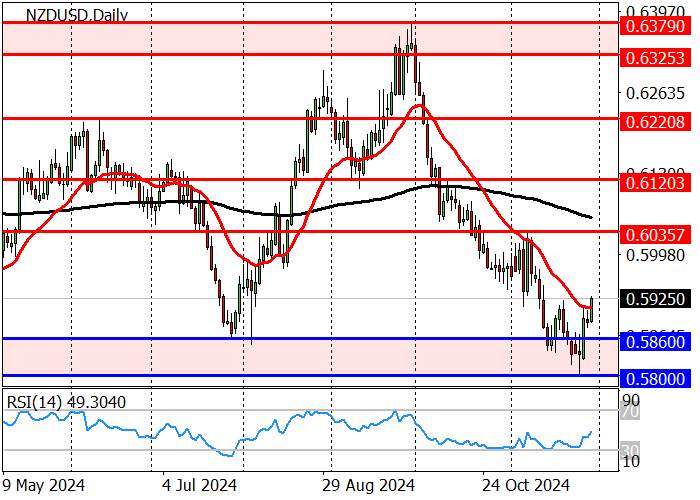
| Scenario | |
|---|---|
| Time frame | Weekly |
| Recommendation | BUY LIMIT |
| Entry point | 0.5890 |
| Take Profit | 0.6030 |
| Stop Loss | 0.5850 |
| The most important levels | 0.5600, 0.5800, 0.5860, 0.6035, 0.6120, 0.6220 |
| Alternative scenario | |
|---|---|
| Recommendation | SELL-STOP |
| Entry point | 0.5790 |
| Take Profit | 0.5600 |
| Stop Loss | 0.5860 |
| The most important levels | 0.5600, 0.5800, 0.5860, 0.6035, 0.6120, 0.6220 |
Current dynamics
After hitting lows in the 0.5800 area, the NZD/USD pair is strengthening towards 0.5927 on the expected 50 basis point cut in interest rates by the Reserve Bank of New Zealand (RBNZ) to 4.25%.
After the meeting, the agency’s chief executive, Adrian Orr, said officials had not considered any option other than -50 basis points for the policy rate adjustment, somewhat disappointing markets that had been expecting a faster rate change. The press release said annual inflation had approached the midpoint of the regulator’s 1.0-3.0% target range, allowing for a continued dovish path at the February meeting as economic conditions continue to evolve in line with the RBNZ’s forecasts, boosting investment. Employment growth is likely to remain weak until mid-2025, but pressure on households will gradually ease. Investors welcomed the regulator’s comments, supporting purchases of the New Zealand dollar, while a -50 basis point adjustment in borrowing costs has already been priced into the NZD/USD pair.
As for the US dollar, at the end of the trading day on November 27, before Thanksgiving, it showed weakness against its main competitors after the publication of gross domestic product (GDP) data, which increased by 2.8% in Q3, although experts expected 3.0%. At the end of October, the personal consumption expenditure price index on an annual basis was 2.3%, justifying the preliminary estimate and exceeding the previous 2.1%, while the core value was recorded at 2.8%, which also coincided with the forecast and was slightly higher than the September value of 2.7%. Despite the increase in inflation, according to the Chicago Mercantile Exchange (CME) FedWatch Tool, the probability of the US Federal Reserve adjusting the interest rate by -25 basis points at the meeting on December 18 is 66.3%, compared to 59.4% previously, which puts pressure on the US dollar, so its downward correction is likely to continue in the medium term.
Support and resistance levels
The long-term trend is down, and within it the price has reached a strong support area at 0.5860-0.5800, from which it rose in September and October 2023, as well as in April and August 2024, and if it is maintained, a correction is expected to develop with a target at 0.6035. If quotations consolidate below the 0.5800 level, a continuation of the decline to the 0.5600 area is likely.
The medium-term trend remains down: yesterday the asset reached zone 4 (0.5819-0.5805), turned around and started an uptrend, within which it tested the trend resistance area at 0.5940-0.5927. If this area is held, the decline will continue to the weekly low of 0.5800, otherwise the medium-term trend will change to up, and long positions with a target in zone 2 (0.6070-0.6057) will become relevant.
Resistance levels: 0.6035, 0.6120, 0.6220.
Support levels: 0.5860, 0.5800, 0.5600.


Trading scenarios
Long positions can be opened from 0.5890 with a target of 0.6030 and a stop-loss of 0.5850. Execution time: 7–9 days.
Short positions can be opened below the 0.5790 level with a target of 0.5600 and a stop-loss around 0.5860.
风险提示:以上内容仅代表作者或嘉宾的观点,不代表 FOLLOWME 的任何观点及立场,且不代表 FOLLOWME 同意其说法或描述,也不构成任何投资建议。对于访问者根据 FOLLOWME 社区提供的信息所做出的一切行为,除非另有明确的书面承诺文件,否则本社区不承担任何形式的责任。
FOLLOWME 交易社区网址: followme.asia


加载失败()